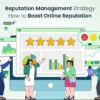At present, the way people think of your brand is more powerful than your actual product or service. From a healthcare clinic to a cafe and IT company, your reputation is the invisible force that influences customer decisions long before they interact with your business.
It only takes a few seconds for a potential customer to form an impression, which is most often based on your online reviews, social media presence, or even how you respond to a complaint. That is why reputation is no longer just a PR concern; it has become a marketing asset.
Check out this blog to find the top reputation management secrets and strategies.
What is reputation marketing
Unlike basic reputation management, which tends to be reactive (like dealing with bad press or putting out issues), reputation marketing is proactive. It is highly focused on highlighting and promoting your brand’s best qualities across digital platforms. It’s about using your positive customer experiences, reviews, and public sentiment as a marketing tool to build trust and attract more customers.
In simple terms, reputation marketing is about making your good reputation visible. You are taking the positive things people say about your brand and amplifying them. This not only enhances credibility but also boosts conversions. When done right, reputation management & marketing help businesses improve brand image, generate more leads, increase customer loyalty, and ensure long-term success.
What are the core reputation marketing strategies
Here are some of the core reputation marketing secrets & strategies:
1. Keep online business listings updated
Keeping your business listings accurate and up to date might seem like a basic step, but it is one of the foundational strategies in reputation marketing.
Make sure your business is listed on popular directories like Google Business Profile, Yelp, Bing Places, Apple Maps, and niche-specific platforms relevant to your industry. Include all key information like business name, address, phone number, operating hours, services offered, website link, and high-quality images. Don’t forget to update listings if you change your hours, relocate, or add new services.
Having accurate listings makes it easy for customers to find you, and it sends positive trust signals to search engines. A complete listing boosts visibility in local SEO results, driving more foot traffic and online conversions. If you want, you can use a listing management tool to maintain consistency across all platforms and avoid outdated or duplicate information that may confuse customers.
2. Showcase authentic online reviews
Online reviews have become modern-day word-of-mouth, and their impact on reputation can’t be overstated. As stated by BrightLocal, 98% of customers read online reviews before making a purchase decision, and that number continues to grow.
That is why you should make it a priority to regularly collect reviews from satisfied customers. Automate post-purchase review requests through email, WhatsApp, or SMS, and encourage customers to leave feedback on Google, Facebook, or industry-specific review platforms like TripAdvisor (for hospitality) or Healthgrades (for healthcare).
One bets brand reputation management solution is to highlight positive reviews on your website homepage, product pages, and even in your email marketing or ad campaigns. Don’t be afraid to share glowing testimonials on your social media pages or in Instagram Stories for added credibility.
3. Respond to negative feedback
One major mistake that many brands make that costs them their reputation is not responding to negative reviews/feedback. At present, customers often view silence as a sign of guilt or apathy. This ultimately makes people think that you do not care about customers and their issues.
The best way to avoid this is to promptly respond to negative feedback/reviews. Analyze the review and see if you can pinpoint the root cause. It is best to acknowledge the customer’s concerns in a respectful and non-defensive manner.
Apologize when necessary and offer to resolve the issue either publicly or privately. This shows your accountability and gives off the impression that you are genuinely willing to make things right. Even when customers don’t respond to your resolution attempt, the public will still notice your professionalism.
Example: If a restaurant receives a negative review about slow service, a good response might be:
Hi (customer name), thank you for your honest feedback. We’re sorry your experience didn’t meet your expectations. We’re currently working on improving our service flow and would love to make it up to you. Please contact us directly so we can address this personally.
The bottom line? When handled well, a negative review can actually boost credibility by showing how your brand deals with real-world problems transparently.
4. Focus on high-quality content
Here is one of the most underrated yet highly effective reputation marketing strategies. Wondering what it is? It is content creation, such as blogs, videos, podcasts, FAQs, and guides, which will help you demonstrate authority in your space.
High-quality content educates your audience, positions your brand as a helpful resource, and builds trust over time. More importantly, when people search for questions related to your industry, your content can be the answer they find. Therefore, this can enhance your reputation. Besides that, guest posting on other trusted industry sites or participating in webinars and panel discussions can enhance your online brand reputation.
5. Engage on social media
You cannot build brand reputation in silence. Brands need to be present, active, and approachable on social media. This means more than just posting updates; it means engaging in real conversations.
Reply to comments, acknowledge mentions and tags, and participate in trending conversations where relevant. If someone praises your product, make sure to thank them. If they have a question, try to answer it promptly. If they express dissatisfaction, respond with empathy and a solution.
In addition to that, it is better to monitor keywords related to your brand so you can track conversations that may not directly tag you but still impact your reputation. When you are present actively, it makes you familiar. And as you know, familiarity builds trust.
6. Corporate social responsibility
At present, the customers want to support brands that stand for something bigger than profits. That’s why the concept of Corporate Social Responsibility (CSR) is being adopted by many brands.
In simple terms, CSR is all about aligning your business with broader social, ethical, and environmental goals. When done authentically, it shows your audience that your brand is committed to making a positive impact instead of simply making money.
According to a study by Zipdo, 76% of companies believe that CSR reduces brand reputation risks. That’s because people are more likely to support businesses that reflect their own values. In addition, share updates about your CSR initiatives on your website, newsletters, and social channels so that your customers are aware of what you are doing.
Here are some examples of CSR:
- A coffee shop chain launching a tree-planting program for every 100 cups sold.
- A tech company donating refurbished laptops to underprivileged schools/people.
- A clothing brand partnering with a local nonprofit to support mental health awareness or any other social cause.
7. Employee engagement
Did you know that your employees can be some of your biggest brand ambassadors? Yes, you heard it right. Happy, engaged employees who share their positive experiences on social media can make your brand more trustworthy and reliable.
It is better to encourage your employees to share behind-the-scenes photos, milestones, or their day-to-day experiences with your company. This builds more trust in your brand among job seekers, customers, and partners alike.
Wrapping up
Reputation marketing is not just about damage control, it is about proactive trust-building across every customer touchpoint. From managing reviews and social media engagement to CSR and employee engagement, these strategies work together to build a brand that people trust, respect, and recommend.





